Arts & Minds Script
Program: Arts & Minds
Interviewee: Mike Nesmith
Date:
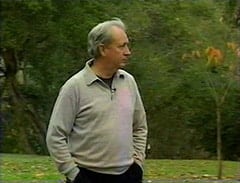
Michael Nesmith walking outside
NARRATOR:
You may not recognize this quiet, wealthy resident of Caramel, California, but you probably know him from the musical group he was once a member of.
“The Monkees” theme plays with the logo on screen, followed by clip from “The Monkees”, followed by a picture of Michael Nesmith from the end credits of the show
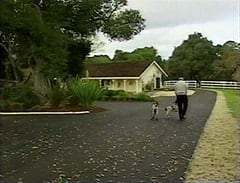
Michael Nesmith walking outside with his dogs
NARRATOR (cont.):
Since the 1970s, Michael Nesmith has worked on his own music, helped create MTV, produced movies like Repo Men, and turned his hand to writing novels.
Michael Nesmith sitting in front of fireplace
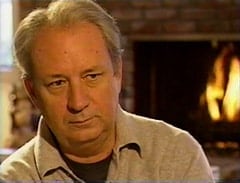
NARRATOR (cont.):
When people say your name, how would you like them to define you? Musician, futurist, entrepreneur?
MICHAEL NESMITH:
[shakes head] Just never crosses my mind. Um… I don’t have any idea of the public perception and don’t, I don’t, I cannot even imagine the percentage of my thinking that’s devoted to it. I don’t even… just never crosses my mind.
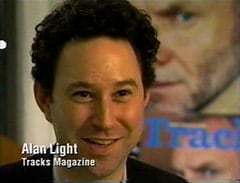
Alan Light (Tracks Magazine)
ALAN LIGHT:
First and foremost, you have to identify Michael Nesmith as one of The Monkees. Um… no matter what other things he accomplishes, that’s always going to be the, uh… the first thing anybody thinks of.
Bob Hamilton (New Radio Star)
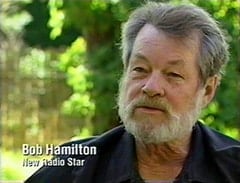
BOB HAMILTON:
When I watched The Monkees, he was really the only part of it that I was interested in.
NARRATOR:
Radio veteran Bob Hamilton has known Michael for over thirty years.
BOB HAMILTON:
Michael is the funniest person that I have ever met in my life, and I, I’ve had count among my acquaintances George Carlin and Steve Martin and Cheech and Chong, and nobody is funnier than Michael Nesmith.
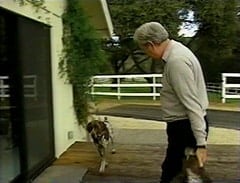
Michael Nesmith walking towards a house
NARRATOR:
He is a funny guy, but the adjective that is most often used by critics to describe Michael is “visionary”—a term he doesn’t quite agree with.
Michael Nesmith in front of fireplace
MICHAEL NESMITH:
I’m very weary of the, of the word “visionary” and “prophet” and “prophetic” and whatever those words are.
Bob Hamilton
BOB HAMILTON:
I was thinking that Michael is a great balance of art and science, but I don’t think Michael differentiates between art and science. I think art and science come together with the fact that he is, he is, uh, in touch with true reality.
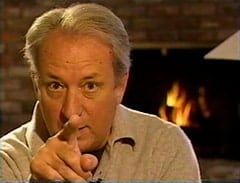
Michael Nesmith
MICHAEL NESMITH:
Defining your world is a world of ideas, and defining your world is a world of spirit. And beginning to reconcile things, when you look at the camera [points to camera], or you look at, uh, something over here [points off-camera], or you look at yourself [looks at self], and you say, “Now that’s a spiritual idea”. If I can understand that, that will give me something, um, to go on, to build my life around. It provides me with judgment, it provides me with insight and wisdom, it provides me with a way to make a living.
clip from “Rio” music video
NARRATOR:
In the late 1970s, Michael developed a show called Pop Clips, which he later sold to Warner Brothers, and this became the inspiration for MTV.
Alan Light
ALAN LIGHT:
There had been music videos before. I mean, The Beatles made music videos, you know, uh, artists in the sixties did to send out to record stores and to do things, you know, when they weren’t on tour or they weren’t out there musically I give music and film and whatever it was at the time existed, but Nesmith was really thinking further, thinking about longer forms, thinking about narratives, and thinking about what is to bring music together with storytelling, visual storytelling.
Michael Nesmith
MICHAEL NESMITH:
I came up with a music video in the mid-seventies. Now, I didn’t know what a music video was. Somebody asked me to make a promotional of my song, “Rio”, so I did.
clip from “Rio” music video
Michael Nesmith
MICHAEL NESMITH (cont.):
When I took it over to play it to the promotion men who were gonna take this clip around, they all sit up and applauding… Didn’t exactly understand what had happened, why they were all so excited about this… “video clip” I had made… until I began to see that the other video clips that were around were just people standing up and singing their song.
clip from “Rio” music video
MICHAEL NESMITH (cont.):
And what I had done was taken certain elements, expressiveness, and ways to express the ideas in a song spiritually and artistically and put those in the film as well. That was fun and it didn’t seem particularly novel or anything to me at the time, but it just seemed like the right thing to do.
Michael Nesmith
MICHAEL NESMITH (cont.):
Where would you play something like that? Can’t play it on radio, television doesn’t want to play it, because television has its talk shows and game shows and stuff that it plays, and cop shows at night, so what do you, how do you, well, you know what would make sense is to have, everybody’s at some point is gonna wanna do these things because they’re so much fun, there’s so much artistry involved in it. You would think that you could just put it on television like records are on radio, play ’em sorta one after another, dedicate a cable channel to it, and it would be sorta like music television… Hey, wait a minute. Why not music television? There you go!
commercial for MTV
TV VOICEOVER:
As Rachel turned on the TV, she knew her life would never be the same.
clip of man singing
MAN:
I want my MTV…
Alan Light
ALAN LIGHT:
There’s no question that he was ahead of the curve on that and, um, in a very genuine way.
Michael Nesmith
MICHAEL NESMITH:
There’s no precedence involved in it. It’s just basically connecting dots. You just sorta see the way things, … my mother invented Liquid Paper.
picture of Michael’s mother, Bette
MICHAEL NESMITH (cont.):
She became very wealthy from it, she was a single woman in Texas…
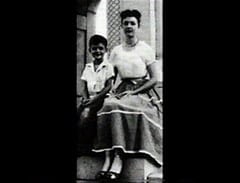
picture of Michael and his mother, Bette
MICHAEL NESMITH (cont.):
…and she raised me and turned this idea into something huge.
picture of paper and a bottle of Liquid Paper
MICHAEL NESMITH (cont.):
Now how did she come up with that idea? Sixty-four dollar question, answer is twenty-three cents. Very, very simple. She was a secretary, and as a secretary, typed letters, and, uh, she worked on a manual typewriter. The electric typewriter came along. [makes typewriter noises] Ribbon’s different, makes a lot of mistakes. Big difference between [makes manual typewriter noises] and [makes electric typewriter noises], and she can’t erase this new paper and this new carbon ribbon, so it’s a dilemma. In the evening, she takes another job, and what’s the job? She’s a graphic artist, and when she would make a mistake on a commercial layout—this was long before Photoshop and many of the software—she paints it out. Wait a minute, I could paint out a typing error! It’s just not any more complex than that, so she did. Now believe me, it’s a long way from there to the multi-million dollar international corporation that she ultimately sold to a big company in America, but the idea was simple. It was a simple just connecting the dots.
clip of Live at the Palais from Elephant Parts
NARRATOR:
In the 1980s, Michael was executive producer on such movies as Elephant Parts and
“Repo Man” logo
NARRATOR (cont.):
Repo Man.
Pacific Arts logo
NARRATOR (cont.):
He also set up his own production and distribution company, Pacific Arts.
Bob Hamilton
BOB HAMILTON:
If you go back to Pacific Arts and what he did with the video company and so on marketing, I mean, he knows marketing very well. Uh, he’s a business man, and he knows business extremely well. You could put him as the CEO of any company in the world, and he would be successful at doing it, but at the same time, Michael’s art has taken much greater precedence, and he has always blazed the trail. He has always been on the forefront of something, and it was not a commercial venture that was motivating him, I don’t believe. I mean, not that he doesn’t want, you know, to do business.
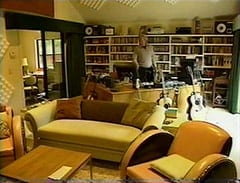
clip of Michael Nesmith in house
MICHAEL NESMITH:
I’m writing a book right now called The America Gene, which is about people hitting their personal Las Vegas.
Michael Nesmith by fireplace
MICHAEL NESMITH (cont.):
Americans come with a potential arc from Tupelo, Mississippi to Las Vegas, Nevada. That’s just one of the things that happens to people in America. And Elvis was a paradox. He lived this out. He started off in Tupelo, cool, you know, white guy singing blues songs, great music, making up art, so forth, and he ended up just utter parody of himself in Las Vegas.
clip of Elvis Presley
Michael Nesmith
MICHAEL NESMITH (cont.):
And I call it the phrase “personal Las Vegas”. He hit his personal Las Vegas in some way, and, um, I thought, that is not just Elvis, that’s for all of us. That actually is something that can happen to people. And then I began to do a little work, like this happened like ten years ago I started thinking about this, and so the notion slowly began to form and I’m thinking about what it means to hit your personal Las Vegas. I remember when I hit my personal Las Vegas. I could see when people were hitting their personal Las Vegas. It’s not a character flaw; it’s just something that happens to Americans. They do things just because they can.
clip of Elvis Presley
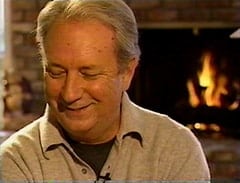
Michael Nesmith
MICHAEL NESMITH (cont.):
Mine came in the late sixties and early seventies. I was back at some of the stuff I was doing, and it was my personal Las Vegas. [laughs]
“The Monkees” logo
ANNOUNCER:
The Monkees… brought to you by… Kellogg’s.
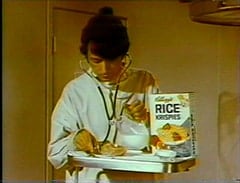
Kellogg’s commercial with Michael in a doctor’s outfit and a bowl of Rice Krispies
Michael Nesmith
MICHAEL NESMITH:
Just having gone from who I was to this, this critter, that was just absolutely foreign to me. I didn’t have any idea who it was. I think I made a lot of people angry, and I think, uh, there was a lot of fall out from it, but not anywhere near so bad just to look back and say, “Gosh, what in the world would motivate something like that?”.
clip of “Daydream Believer” music video
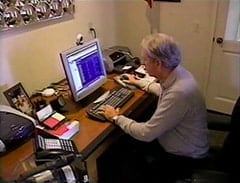
Michael Nesmith at computer on Videoranch website
NARRATOR:
Michael remains in contact with fans via his own website, videoranch.com, which has an impressive catalog of music and video, and it’s this digital world with its hyperlinks that excites him these days.
MICHAEL NESMITH:
Nothing is more powerful than an idea whose time has come.
Michael Nesmith by fireplace
MICHAEL NESMITH (cont.):
You can see it in every enlightened future that you can find, from Buddha to, uh… to, uh… uh… Buddha.
Bob Hamilton
BOB HAMILTON:
I think Michael’s greatest work may not be done yet. Um, I think that he’s learning all the time, you know, trying new things constantly, but he’s always on the forefront.
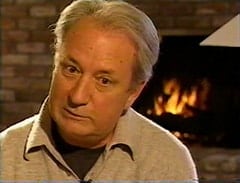
Michael Nesmith
MICHAEL NESMITH:
When you see that idea, and you get it, it grows like a flower, it just grows in the pot. And all you have to do then is be a gardener. You just water it, tend it, let it grow, and… is gardening hard work? Yuh. And does gardening cause you to sweat and worry? Yuh. Does it mean, “Oh, I don’t know whether I’m ever gonna make it, am I ever gonna be…?” Yuh. You have to do certain things. You have to get up at three o’clock in the morning and tend things? Yuh. You’ve gotta do all that stuff, but the thing you’re doing at that point is gardening. You’re not, you’re not trying to make something come into being. That’s the, that’s the power of it, that’s the magic trick.
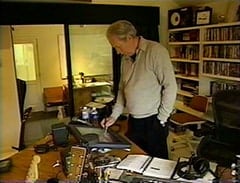
Michael Nesmith at computer
NARRATOR:
Michael is always thinking of the future, not the past. Even though The Monkees made him a success, he feels that fame stole something from him.
Michael Nesmith by fireplace
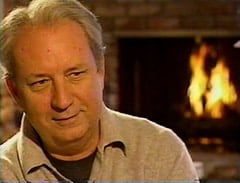
MICHAEL NESMITH:
People come and they would have a certain notion about, um… who they were approaching, what they were approaching, what would be proper to say and so forth, and so I made a decision a long time ago not to contribute to that. That wasn’t a good thing that that was apparently something that, uh, made the transaction and made the interaction less than stellar. [smiles] So I just, I decided I wouldn’t think about it, and at least for my part, I would just take people as they came.